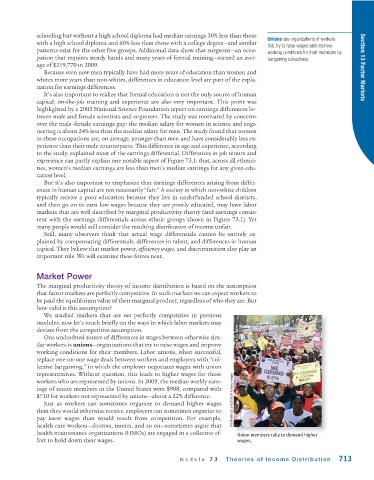Page 755 - Krugmans Economics for AP Text Book_Neat
P. 755
schooling but without a high school diploma had median earnings 30% less than those
Unions are organizations of workers
with a high school diploma and 60% less than those with a college degree—and similar
that try to raise wages and improve
patterns exist for the other five groups. Additional data show that surgeons—an occu- working conditions for their members by
pation that requires steady hands and many years of formal training—earned an aver- bargaining collectively.
age of $219,770 in 2009. Section 13 Factor Markets
Because even now men typically have had more years of education than women and
whites more years than non-whites, differences in education level are part of the expla-
nation for earnings differences.
It’s also important to realize that formal education is not the only source of human
capital; on-the-job training and experience are also very important. This point was
highlighted by a 2003 National Science Foundation report on earnings differences be-
tween male and female scientists and engineers. The study was motivated by concerns
over the male–female earnings gap: the median salary for women in science and engi-
neering is about 24% less than the median salary for men. The study found that women
in these occupations are, on average, younger than men and have considerably less ex-
perience than their male counterparts. This difference in age and experience, according
to the study, explained most of the earnings differential. Differences in job tenure and
experience can partly explain one notable aspect of Figure 73.1: that, across all ethnici-
ties, women’s median earnings are less than men’s median earnings for any given edu-
cation level.
But it’s also important to emphasize that earnings differences arising from differ-
ences in human capital are not necessarily “fair.” A society in which non-white children
typically receive a poor education because they live in underfunded school districts,
and then go on to earn low wages because they are poorly educated, may have labor
markets that are well described by marginal productivity theory (and earnings consis-
tent with the earnings differentials across ethnic groups shown in Figure 73.1). Yet
many people would still consider the resulting distribution of income unfair.
Still, many observers think that actual wage differentials cannot be entirely ex-
plained by compensating differentials, differences in talent, and differences in human
capital. They believe that market power, efficiency wages, and discrimination also play an
important role. We will examine these forces next.
Market Power
The marginal productivity theory of income distribution is based on the assumption
that factor markets are perfectly competitive. In such markets we can expect workers to
be paid the equilibrium value of their marginal product, regardless of who they are. But
how valid is this assumption?
We studied markets that are not perfectly competitive in previous
modules; now let’s touch briefly on the ways in which labor markets may
deviate from the competitive assumption.
One undoubted source of differences in wages between otherwise sim-
ilar workers is unions—organizations that try to raise wages and improve
working conditions for their members. Labor unions, when successful,
replace one-on-one wage deals between workers and employers with “col-
lective bargaining,” in which the employer negotiates wages with union
representatives. Without question, this leads to higher wages for those
workers who are represented by unions. In 2009, the median weekly earn-
ings of union members in the United States were $908, compared with
$710 for workers not represented by unions—about a 22% difference. STEPHANE DE SAKUTIN/AFP/Getty Images
Just as workers can sometimes organize to demand higher wages
than they would otherwise receive, employers can sometimes organize to
pay lower wages than would result from competition. For example,
health care workers—doctors, nurses, and so on—sometimes argue that
health maintenance organizations (HMOs) are engaged in a collective ef- Union members rally to demand higher
fort to hold down their wages. wages.
module 73 Theories of Income Distribution 713

